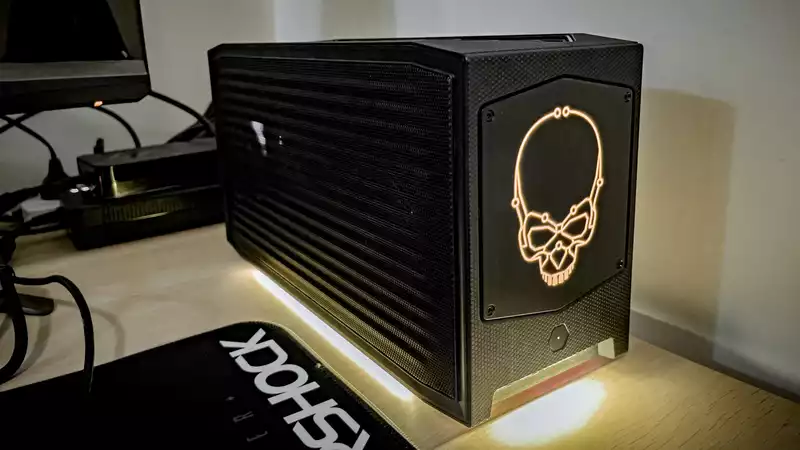The Intel NUC Beast Canyon is the Godzilla of NUCs. But it may be the Godzilla of NUCs because it's still small: starting at $1,399, the Beast Canyon is built around the Intel NUC 11 Extreme. Somehow Intel has managed to fit a full-sized discrete GPU alongside the NUC 11 Extreme, making it one of the most interesting small form factor gaming rigs I've come across. At only 8 liters, the chassis is adorned with a striking "Calaveras"-style skull logo on the front that makes quite a statement (and raises many eyebrows) when displayed on a desk or in a TV cabinet.
The Beast Canyon comes with either a Core i9 or Core i7 processor. Here we have the flagship Core i9 11900KB, which is part of the special 65W B-series Tiger Lake family. The base clock is a slow 3.3Ghz and boost is only 4.3Ghz.
However, it is unlocked and can extract a bit more. In our tests, the benefits of overclocking are not obvious, as this CPU performs more than adequately in most games. The unit sent for testing was equipped with an Asus Dual RTX 3060 Ti, 16GB of RAM, and a 512GB NVMe M.2 SSD. Of course, Beast's modularity allows these to be replaced with higher capacity components.
At the heart of each Beast Canyon is a Compute Element, with the CPU soldered to the motherboard and connected to the rest of the system via a PCIe 4.0 x16 slot. This can be replaced for future upgrades; the Compute Element contains the bulk of the IO, including dual Thunderbolt 4, eight USB 3.1 Gen 2, UHS-II SD card reader, 2.5Gb Ethernet, HDMI 2.0 It can also accommodate up to two HDMI 2.1 and one DisplayPort 1.4, depending on whether or not a discrete GPU is installed.
The Beast Canyon measures 14.1 inches front to back, 7.4 inches wide, and 4.7 inches tall, enough to accommodate a 12-inch discrete GPU and a 650W 80Plus Gold power supply.
There is a proud skull logo on the front, which you either love or hate, the latter for me. It also has RGB lighting, which makes it stand out even more. There is more RGB lighting under the chassis, and overall the look is not bad at all. The additional USB, SD card reader, and headphone jack on the front of the case are also a nice touch.
Now, as for performance, your mileage may vary depending on your particular configuration. The tester delivered impressive results on all fronts, as evidenced by its Cinebench score (11,058) and Geekbench Multicore score (8505), where productivity and creative tasks are handled with flying colors.
Daily use in Windows, web browsing, Adobe Lightroom editing, and general tasks were done in no time with no fuss; 3DMark 11 and Uniengine Superposition all produced excellent results, which is a real world games carried over, with all titles tested running well above 60 FPS at 1080p and 1440p at the highest settings.
Thanks to Nvidia's tensor and the arcane power of DLSS 2.0, we were even able to run 4K games at 60 FPS at medium to high settings; even "Metro Exodus Enhanced Edition" averaged 56 FPS, and "Forza Horizon 4" ran at 4K at 103 FPS at 4K, which was very smooth. In short, those looking for the perfect PC to pair with a 4K HDMI 2.1 compatible TV will not be disappointed.
As you can imagine, these performance numbers had us concerned about heat generation, but that concern was quickly dispelled. The triple 92mm fan radiator at the top of the case and mesh panels kept everything really cool, with average CPU and GPU temperatures in the low 70s, even after playing Destiny 2 Beyond Light at 4K60ps for an unhealthily long time.
Additionally, noise was minimal and not as noticeable as on most gaming laptops. This makes the Beast Canyon a great living room gaming machine that can be plugged into a TV and not irritate neighbors with fan noise.
As it turns out, I was really impressed with the Intel NUC Beast Canyon. The model I reviewed cost about $3,000, which is frankly way too much; you might think that a NUC kit would bring the overall price down, but it didn't.
For this amount of money, you can get more powerful hardware (albeit in a large ITX case) that delivers far better performance, upgradability, and longevity. Still, if you don't want the complexity of building your own small PC that will do great work in your living room or on your desk, the Beast Canyon may be the answer. An expensive answer, to be sure, but an answer nonetheless.
.

Comments